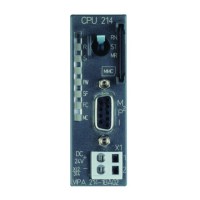Manual VIPA CPU 21x Chapter 5 Deployment CPU 21x-2BT02 with H1 / TCP/IP
HB103E - Rev. 05/45 5-5
TCP/IP protocols are available on all major systems. At the bottom end this
applies to simple PCs, through to the typical mini computer up to main-
frames (TCP/IP implementations also exist for IBM systems) and special
processors like vector processors and parallel computers. For this reason
TCP/IP is often used to assemble heterogeneous system pools.
TCP/IP can be employed to establish extensive open network solutions
between the different business units of an enterprise.
For example, TCP/IP may be used for the following applications:
• centralized control and supervision of production plants,
• transfer of the state of production machines,
• management information,
• production statistics,
• the transfer of large quantities of data.
TCP and IP only provide support for two of the protocols required for a
complete architecture. Programs like "FTP" and "Telnet" are available for
the application layer of the PC.
The application layer of the CPU 21x2BT02 CP is defined by the
application program using the standard handler blocks.
These application programs exchange data by means of the TCP or UDP
protocols of the transportation layer. These themselves communicate with
the IP protocol of the Internet layer.
IP
The main purpose of IP is to provide the addressing of data packets. This
means that IP has the same function as an envelope has for a letter. The
address is used by the network to determine the destination and to route
the data packets accordingly.
The protocol divides the data into small portions since different networks
use differently sized data packets.
A number is assigned to each packet. This is used to acknowledge
reception and to reassemble the original data. To transfer these sequence
numbers via the network TCP and IP is provided with a unique envelope
where these numbers are recorded.
TCP
A packet of data is inserted into a TCP envelope. This is then inserted into
an IP-envelope and transferred to the network. TCP provides for the
secure transfer of data via network. TCP detects and corrects communica-
tion errors.
In this way TCP connections are relatively safe.
UDP provides a much faster communication link. However, it does not
cater for missing data packets, nor does it check the sequence of the
packets. UDP is an unsecured protocol.
TCP/IP

